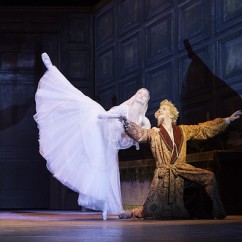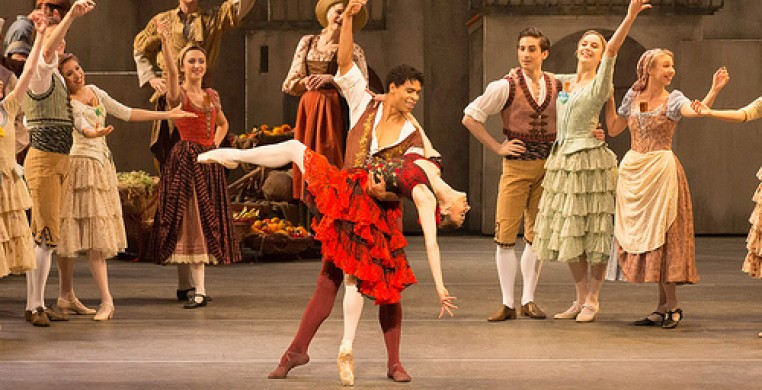There are times when the rare chemistry of great artistry and a great audience creates a uniquely thrilling evening of live theater. Such was the case opening night of The Royal Ballet’s first Chicago appearance in thirty-seven years, a long time to wait to see Great Britain’s crown jewels of the dance. It’s safe to say the royal treatment they graced upon Chicago with principal guest artist Carlos Acosta’s production of “Don Quixote” (2013) rekindled a love affair on both sides of the pond.
The packed Auditorium Theatre audience’s excitement was palpable, from the magical opening moments of Don Quixote’s dream encounter with his ethereal Dulcinea to the invigorating full-throttle finale some three hours later. The dancers responded to the immediacy of our embrace with a uniformly joyous performance that grew in warmth and enthusiasm with each engaging scene until it fairly burst with exuberance in the Act Three grand pas de deux.
There are many wonderful things about this production, not the least of which is simply some of the most brilliant ballet dancing you’re ever likely to see, but what stands out above and beyond the glittering facets of this gem is the magnitude and scope of Acosta’s production, as exemplified by the company itself.
Acosta, who danced the lead role of Basilio on Thursday night, faithfully follows the original story and dance sequences set by Marius Petipa in 1869 on the Ballet of the Imperial Bolshoi Theatre of Moscow to music by Ludwig Minkus and based on two chapters of the novel, “Don Quixote de la Mancha,” written by Miguel de Cervantes in 1605 and 1615.
Cervantes’ novel was first adapted for ballet in 1740 and has flourished ever since as the source of many interpretations, including contemporary ballet versions by Balanchine, Nuryev, Baryshnikov, and San Francisco Ballet’s Helgi Thómasson and Yuri Possokhov.
Acosta’s version, while faithful to tradition in the grand style of 19th-Century classical ballet, adds theatrical substance that elevates an over-used and fairly banal plot that too often serves a production merely as a clothes line for pretty costumes or as an excuse for a parade of company stars in knock-out variations. Acosta overcomes that trap by making the most of The Royal Ballet’s tradition of serious attention to the acting and by using the astounding strength of its corps de ballet. Not only are all the characters in this Don Q fully defined and three-dimensional, but every member of the ensemble is fully invested in who and where they are on stage and with each other. No one is ever “just dancing;” they are in the scene, in relationship, and in the story. The result is a believable world inhabited by real people that lets a modern audience engage emotionally with historic theatrical conventions that defy today’s expectation of psychological realism.
So we have stellar soloists dazzling with sumptuous variations, but they dance for the entertainment of the village regulars gathered in the town square, at a gypsy camp, or in a tavern. What’s more, the “village regulars” are real people with real voices--yes, dancers can speak, and they do, in lively crowd scenes replete with convincing stage business around the little details of daily life. And they grab every opportunity to entertain themselves by celebrating life’s gifts with a dance, usually with a distinctly Spanish accent. Character dances were deftly staged in the town square, gypsy camp, and tavern with flare and excitement, with stand-out performances from Ryoichi Hirano as Espada, A Famous Matador, Laura Morera as a fiery Street Dancer, and Thomas Whitehead and Itziar Mendizabel as an earthy Gypsy Couple. Special kudos to the all the Matadors and their ladies, and to the barefoot street urchins whose jaunty antics peppered the stage with adolescent irreverence and fun.
It’s not often that a prop commands critical accolades, but Don Q’s mechanical horse, designed by Tim Hatley, was a star in his own right, a haggard old fellow with a personality and equine choreography all his own. Hatley’s rich forced-perspective sets kept the story moving, quite literally, with plenty of colorful period spectacle and a dream scene forest with foreboding branches and fanciful giant flowers.
The dream ballet of Act Two is a spectacle unto itself, exemplifying the epitome of beauty in classical corps de ballet choreography and execution. Melissa Hamilton as Queen of the Dryads, Meaghan Grace Hinkis as Amour, and Christina Arestis as Dulcinea were dream ballerinas of the highest order, worthy of Don Q’s quest.
Christopher Saunders’ wistful Don Q brought humor and pathos to the story, trading his quest for the unattainable dream woman for the real-life quest to make things right with the world at hand, seeing to it that true love could take its proper course.
 Don Quixote
Acosta’s Don Basilio, his final performance in the role, exuded boyish charm and unabashed devotion to Marianela Nuñez’s coy Kitri. Even in these final months of his performing career, the ease and grace of his spot-on technique and magnanimous artistry characterize this ballet superstar. In Act One, at times, Nuñez’s technical brilliance overshadowed her acting, which seemed forced, but as the ballet progressed she grounded herself in the role, and by the finale had won the hearts, and cheers, of the entire house. Her electrifying execution of the requisite Act Three thirty-two fouetté turns more than dazzled, with soaring confidence and Kitri’s almost giddy relief at finally getting her guy.
Don Quixote
Acosta’s Don Basilio, his final performance in the role, exuded boyish charm and unabashed devotion to Marianela Nuñez’s coy Kitri. Even in these final months of his performing career, the ease and grace of his spot-on technique and magnanimous artistry characterize this ballet superstar. In Act One, at times, Nuñez’s technical brilliance overshadowed her acting, which seemed forced, but as the ballet progressed she grounded herself in the role, and by the finale had won the hearts, and cheers, of the entire house. Her electrifying execution of the requisite Act Three thirty-two fouetté turns more than dazzled, with soaring confidence and Kitri’s almost giddy relief at finally getting her guy.
The Royal Ballet has certainly made things right with Chicago! The splendor of this company’s artistic reach is exemplified by the sheer size of its lavish operation, its depth of talent, from principals right down through the ranks, and its ability to revitalize a full-length 19th-Century war-horse of a ballet like “Don Quixote” with such vitality, humor, and theatrical viability. Bravo! Chicago thanks you!
Performances continue through Sunday. For tickets and information,go to seechicagodance.com, and click on "Upcoming Events."

